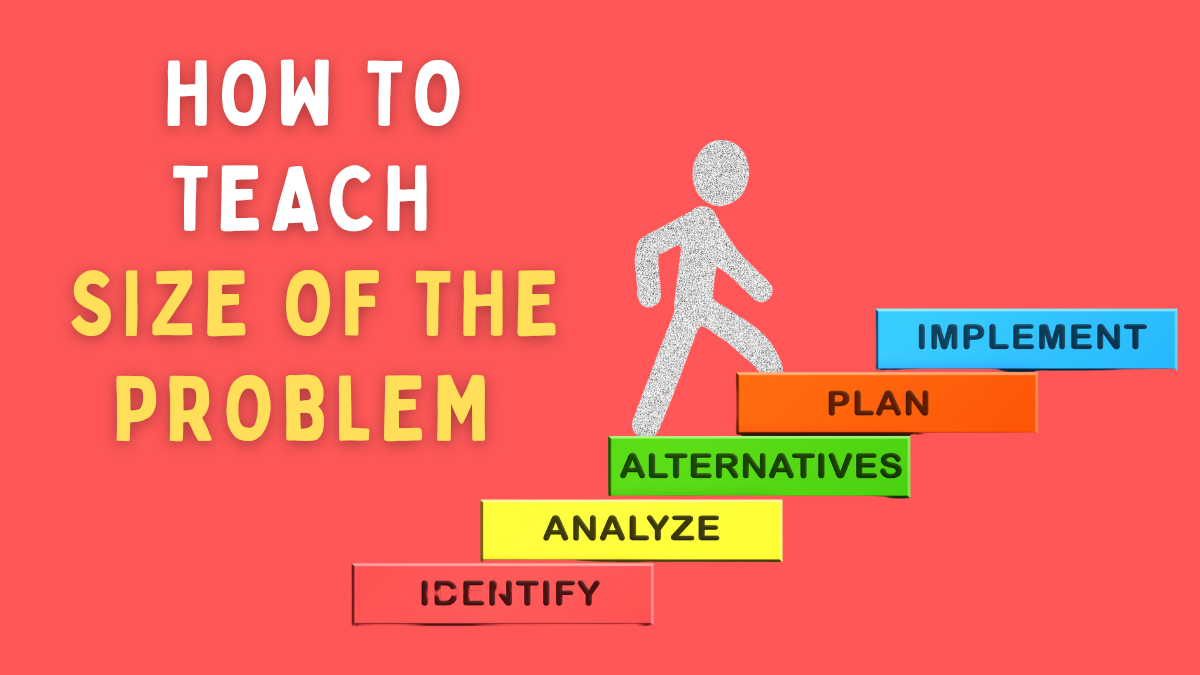How to Teach Size of the Problem

Teach kids how to reflect, not just react! Explore a way to problem-solving that validates feelings and builds emotional intelligence.
Teaching Kids to Reflect: A Better Way to Teach Size of the Problem
Have you ever been upset about something and someone tells you, “Calm down,” or “It’s not a big deal”? That’s probably one of the worst things you can hear when you're already struggling. It might not be a big deal to them, but it is to you.
We need to remember that when we teach our students about how to deal with problems they encounter.
For example, what if a student starts crying over a broken pencil? That might sound like something minor, right? But what if that pencil was given to you by your best friend before they moved away? Or what if you got it on a special trip and can’t replace it? Suddenly, that “small” problem carries a lot more emotional weight.
Why All Feelings Are Valid in Social-Emotional Learning (SEL)
Many educators and therapists teach kids how to rate their problems and I agree that that is important. But in my social skills groups, I take a slightly different path.
When I teach the Size of the Problem to kids, the purpose is to build emotional intelligence, self-regulation, or conflict resolution skills. So I want them to think for themselves!
A Reflective Scale for Emotional Intelligence and Problem Solving
Here’s how the scale works:

All Good – No intervention needed. The problem is real, but you can brush it off or self-regulate quickly.
-
Handle It Alone – You can solve it yourself using a tool or strategy you’ve learned.
-
Need Advice or Support – It’s not overwhelming, but getting another perspective could help.
-
Need an Adult or Ally with You – The problem is tough or emotional, and you’d feel better if someone helped you through it.
-
Emergency – It’s unsafe, deeply upsetting, or beyond what you can handle right now.
Teach Kids to Self- Reflect to build Self-Awareness
The goal of this method is not for adults or teachers to dictate where a problem “should” fall in terms of severity but rather to help kids learn to reflect and make that call themselves. That’s the heart of emotional intelligence.

We want kids to learn to pause, evaluate, and respond instead of simply reacting.
To help them evaluate their problems a bit more objectively, I use this framework to guide the process. (This is one part of a complete Problem Size Resource.)
Practice Through Social Scenarios in Social Skills Groups
In my groups we use real-life social situations to practice. I present students with different, relatable, problematic social scenarios. Then they think about how it and determine what they would need to solve it. Sometimes they disagree with each other. One situation might be a big deal to one student but to another it's something that doesn't even require any attention to another. That’s great! Those conversations build perspective-taking, empathy, and critical thinking skills.
A Resource for SEL Lessons and Counseling Sessions
If you’re looking for a structured way to teach this in your own setting, I created a few resources for it.

Problem Size BINGO is a fun way to introduce different levels of problems and ways to get support. The BINGO Board has the icons that represent different levels of problems and the calling cards are the scenarios. Since everyone is different, they may (and probably will!) mark off their BINGO Boards differently. Again, that's more than OK!
There is a similar resource that includes a card game component to it as well that may be helpful for a way for your students to practice in a way that's fun and light hearted.
Empower Kids Through Reflection
When we teach kids how to reflect on the size of a problem, we’re giving them tools for problem-solving, emotional resilience, and social success. These are the skills they will carry into adulthood with.
It starts by kids learning to honor their own feelings. From there, they explore, reflect, and figure out what they need-not what we think they need.
Categories: : problem solving

I'm a Board Certified Behavior Analyst and former Special Education Teacher dedicated to teaching kids the 21st Century Social Skills they need to live happier, healthier lives
Diana Cortese
Founder, Teach Social Skills
 Diana Cortese
Diana Cortese 
